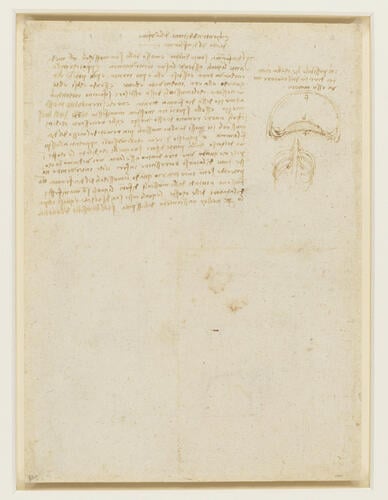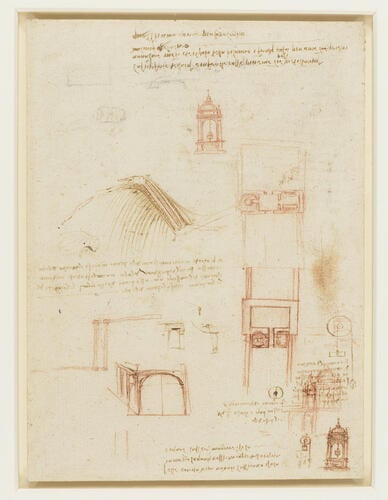-
1 of 253523 objects
Studies of ribs and the diaphragm (recto); Studies of architecture and a bird's wing (verso) c.1512-13
Recto: Pen and ink. Verso: Red chalk, pen and ink, | 27.4 x 20.1 cm (sheet of paper) | RCIN 919107
-
On the recto, a drawing of ribs; a diagram of the diaphragm in respiration with a note on its action.
On the verso: a note on hydrostatics; an elevation of a fountain; a ground-plan of two courtyards; a study of a bird's wing; slight architectural studies; a pulley, with notes on its action; two architectural elevations; notes on water and the earth. Most of the page is concerned with improvements to the Villa Melzi (cf. RCIN 919077), and it may thus be dated to Leonardo’s prolonged stay there in 1512-13.
At the centre is a study of a bird’s left wing from above. A bird’s wing is analagous to the upper limb of a quadruped in that it has a humerus, radius and ulna, but the bones of the wrist are reduced to two small nuggets, and the digits are reduced in number and the bones partly fused, for example in the carpometacarpus, the first major element in the ‘hand’. Here the drawing concentrates on the central section of radius and ulna, with the humerus lightly sketched to the right and the phalanges to the left. The quills of the secondary flight feathers are shown attached to the ulna, with a few primaries attached to the carpometacarpus and basal phalanx. Running along the upper side of the radius is the extensor carpi radialis muscle (n m), as shown in more detail on 912656, and along the lower side of the ulna is the expansor secondarium muscle (a b), responsible for maintaining the correct angle of the secondaries. Leonardo correctly notes its function thus: "The tendon a b moves all the tips of the feathers toward the elbow of the wings, in flexing the wings; but in extending the wing by means of the pull of the muscle n m those feathers direct their lengths towards the point of the wings."
The joints of the radius and ulna with the carpometacarpus and humerus are arranged so that the phalanges maintain approximately the same angle relative to the humerus whatever the position of the wing (sketched both extended and flexed at centre left). In red chalk at lower left Leonardo reduced this arrangement to a simple system of hinged rods, with the analogues of the radius and ulna forming a long parallelogram such that the analogues of the carpometacarpus and humerus remain parallel in any position.
Text from M. Clayton and R. Philo, Leonardo da Vinci: Anatomist, London 2012.
Provenance
Bequeathed to Francesco Melzi; from whose heirs purchased by Pompeo Leoni, c.1582-90; Thomas Howard, 14th Earl of Arundel, by 1630; probably acquired by Charles II; Royal Collection by 1690
-
Creator(s)
Acquirer(s)
-
Medium and techniques
Recto: Pen and ink. Verso: Red chalk, pen and ink,
Measurements
27.4 x 20.1 cm (sheet of paper)
Other number(s)

